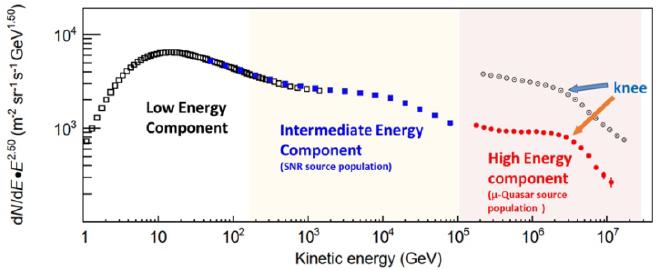

The cause of the “knee” has remained unclear since its discovery nearly 70 years ago. Scientists have speculated that it is linked to the acceleration limit of the astrophysical sources of cosmic rays and reflects the transition of the cosmic ray energy spectrum from one power-law distribution to another.
Now, however, two recent studies—published in National Science Review and Science Bulletin, respectively—demonstrate that micro-quasars driven by black hole system accretion are powerful particle accelerators in the Milky Way and are the likely source of the “knee.” The studies also advance our understanding of the extreme physical processes of black hole systems.
The research was conducted by researchers from the Institute of High Energy Physics of the Chinese Academy of Sciences (CAS), Nanjing University, the University of Science and Technology of China under CAS, La Sapienza University of Rome, and other institutions.
Black holes, one of the most enigmatic objects in the universe, generate relativistic jets when accreting material from companion stars in binary systems, forming “micro-quasars.” In this study, LHAASO systematically detected for the first time ultra-high-energy gamma rays from five micro-quasars: SS 433, V4641 Sgr, GRS 1915+105, MAXI J1820+070, and Cygnus X-1.
These results prove that micro-quasars are significant PeV particle accelerators in the Milky Way, addressing a long-standing issue in science: While supernova remnants were historically recognized as cosmic ray sources, both observational and theoretical studies have shown that they cannot accelerate cosmic rays to the energies of the “knee” and beyond.
In this study, leveraging its world-leading ground-based cosmic ray observational equipment, LHAASO developed multi-parameter measurement techniques and selected a large statistical sample of high-purity protons, allowing for precise measurement of their energy spectrum, with precision comparable to that of satellite experiments. This measurement revealed an energy spectrum structure that was entirely unexpected, clearly displaying a new “high-energy component” instead of a simple transition between power-law spectra.
LHAASO’s new findings, together with the low-energy component measured by the space-borne AMS-02 experiment and the intermediate-energy component measured by the space-borne DArk Matter Particle Explorer (DAMPE) experiment, revealed the existence of multiple accelerators within the Milky Way, with each possessing its own unique acceleration capability and energy range. The “knee” represents the acceleration limit of the sources responsible for generating the high-energy component.
These two discoveries support each other, presenting a comprehensive scientific picture. This not only marks a significant advancement in resolving the long-standing mystery of the “knee” origin, but also offers crucial observational evidence for understanding the role of black holes in the origin of cosmic rays.
LHAASO, which was designed, constructed, and is operated by Chinese scientists, has taken the lead in high-energy cosmic-ray researches due to its sensitivity in both gamma ray astronomical exploration and cosmic ray precision measurement. It has achieved a series of discoveries that have a global impact, thereby contributing to our knowledge of the extreme physical processes in the universe.

Citation #
- The study Precise measurements of the cosmic ray proton energy spectrum in the “knee” region from LHAASO Collaboration was published in Science Direct. LHAASO Collaboration authors: Zhen Cao, F. Aharonian, Y.X. Bai, Y.W. Bao, D. Bastieri, X.J. Bi, Y.J. Bi, W. Bian, A.V. Bukevich, C.M. Cai, W.Y. Cao, Zhe Cao, J. Chang, J.F. Chang, A.M. Chen, E.S. Chen, G.H. Chen, H.X. Chen, Liang Chen, Long Chen, M.J. Chen, M.L. Chen, Q.H. Chen, S. Chen, S.H. Chen, S.Z. Chen, T.L. Chen, X.B. Chen, X.J. Chen, Y. Chen, N. Cheng, Y.D. Cheng, M.C. Chu, M.Y. Cui, S.W. Cui, X.H., Y.D. Cui, B.Z. Dai, H.L. Dai, Z.G. Dai, Danzengluobu, Y.X. Diao, X.Q. Dong, K.K. Duan, J.H. Fan, Y.Z. Fan, J. Fang, J.H. Fang, K. Fang, C.F. Feng, H. Feng, L. Feng, S.H. Feng, X.T. Feng, Y. Feng, Y.L. Feng, S. Gabici, B. Gao, C.D. Gao, Q. Gao, W. Gao, W.K. Gao, M.M. Ge, T.T. Ge, L.S. Geng, G. Giacinti, G.H. Gong, Q.B. Gou, M.H. Gu, F.L. Guo, J. Guo, X.L. Guo, Y.Q. Guo, Y.Y. Guo, Y.A. Han, O.A. Hannuksela, M. Hasan, H.H. He, H.N. He, J.Y. He, X.Y. He, Y. He, S. Hernández-Cadena, B.W. Hou, C. Hou, X. Hou, H.B. Hu, S.C. Hu, C. Huang, D.H. Huang, J.J. Huang, T.Q. Huang, W.J. Huang, X.T. Huang, X.Y. Huang, Y. Huang, Y.Y. Huang, X.L. Ji, H.Y. Jia, K. Jia, H.B. Jiang, K. Jiang, X.W. Jiang, Z.J. Jiang, M. Jin, S. Kaci, M.M. Kang, I. Karpikov, D. Khangulyan, D. Kuleshov, K. Kurinov, B.B. Li, Cheng Li, Cong Li, D. Li, F. Li, H.B. Li, H.C. Li, Jian Li, Jie Li, K. Li, L. Li, R.L. Li, S.D. Li, T.Y. Li, W.L. Li, X.R. Li, Xin Li, Y. Li, Y.Z. Li, Zhe Li, Zhuo Li, E.W. Liang, Y.F. Liang, S.J. Lin, P. Lipari, B. Liu, C. Liu, D. Liu, D.B. Liu, H. Liu, H.D. Liu, J. Liu, J.L. Liu, J.R. Liu, M.Y. Liu, R.Y. Liu, S.M. Liu, W. Liu, X. Liu, Y. Liu, Y. Liu, Y.N. Liu, Y.Q. Lou, Q. Luo, Y. Luo, H.K. Lv, B.Q. Ma, L.L. Ma, X.H. Ma, J.R. Mao, Z. Min, W. Mitthumsiri, G.B. Mou, H.J. Mu, A. Neronov, K.C.Y. Ng, M.Y. Ni, L. Nie, L.J. Ou, P. Pattarakijwanich, Z.Y. Pei, J.C. Qi, M.Y. Qi, J.J. Qin, A. Raza, C.Y. Ren, D. Ruffolo, A. Sáiz, D. Semikoz, L. Shao, O. Shchegolev, Y.Z. Shen, X.D. Sheng, Z.D. Shi, F.W. Shu, H.C. Song, V. Stepanov, Y. Su, D.X. Sun, H. Sun, Q.N. Sun, X.N. Sun, Z.B. Sun, N.H. Tabasam, J. Takata, P.H.T. Tam, H.B. Tan, Q.W. Tang, R. Tang, Z.B. Tang, W.W. Tian, C.N. Tong, L.H. Wan, C. Wang, G.W. Wang, H.G. Wang, J.C. Wang, K. Wang, Kai Wang, Kai Wang, L.P. Wang, L.Y. Wang, L.Y. Wang, R. Wang, W. Wang, X.G. Wang, X.J. Wang, X.Y. Wang, Y. Wang, Y.D. Wang, Z.H. Wang, Z.X. Wang, Zheng Wang, D.M. Wei, J.J. Wei, Y.J. Wei, T. Wen, S.S. Weng, C.Y. Wu, H.R. Wu, Q.W. Wu, S. Wu, X.F. Wu, Y.S. Wu, S.Q. Xi, J. Xia, J.J. Xia, G.M. Xiang, D.X. Xiao, G. Xiao, Y.L. Xin, Y. Xing, D.R. Xiong, Z. Xiong, D.L. Xu, R.F. Xu, R.X. Xu, W.L. Xu, L. Xue, D.H. Yan, T. Yan, C.W. Yang, C.Y. Yang, F.F. Yang, L.L. Yang, M.J. Yang, R.Z. Yang, W.X. Yang, Z.H. Yang, Z.G. Yao, X.A. Ye, L.Q. Yin, N. Yin, X.H. You, Z.Y. You, Q. Yuan, H. Yue, H.D. Zeng, T.X. Zeng, W. Zeng, X.T. Zeng, M. Zha, B.B. Zhang, B.T. Zhang, C. Zhang, F. Zhang, H. Zhang, H.M. Zhang, H.Y. Zhang, J.L. Zhang, Li Zhang, P.F. Zhang, P.P. Zhang, R. Zhang, S.R. Zhang, S.S. Zhang, W.Y. Zhang, X. Zhang, X.P. Zhang, Yi Zhang, Yong Zhang, Z.P. Zhang, J. Zhao, L. Zhao, L.Z. Zhao, S.P. Zhao, X.H. Zhao, Z.H. Zhao, F. Zheng, W.J. Zhong, B. Zhou, H. Zhou, J.N. Zhou, M. Zhou, P. Zhou, R. Zhou, X.X. Zhou, X.X. Zhou, B.Y. Zhu, C.G. Zhu, F.R. Zhu, H. Zhu, K.J. Zhu, Y.C. Zou, X. Zuo.
Acknowledgements #
We would like to thank -the researcher said- all staff members who work at the LHAASO site at 4400 meters above sea level year round to maintain the detector and keep the water recycling system, electricity power supply and other components of the experiment operating smoothly. We are grateful to the Chengdu Management Committee of Tianfu New Area for the constant financial support for research using LHAASO data. We appreciate the computing and data service support provided by the National High Energy Physics Data Center for the data analysis in this paper. This research work was supported by the National Key R&D Program of China (2024YFA1611401, 2024YFA1611402, 2024YFA1611403, 2024YFA1611404), the National Natural Science Foundation of China (12393851, 12393852, 12393853, 12393854, 12205314, 12105301, 12305120, 12261160362, 12105294, U1931201, 12375107, 12275280, 12105293, 11905240, 12375106, 12261141691), Innovation Project of IHEP (E25451U2), Sichuan Province Science Foundation for Distinguished Young Scholars (2022JDJQ0043), the Youth Innovation Promotion Association of the Chinese Academy of Sciences (CAS YIPA) (2023019). We are grateful to the Institute of Plateau Meteorology, CMA Chengdu to maintain meteorological data, and Thailand’s National Science and Technology Development Agency (NSTDA) and National Research Council of Thailand (NRCT) under the High-Potential Research Team Grant Program (N42A650868).
- The article LHAASO Uncovers Mystery of Cosmic Ray “Knee” Formation – Chinese researchers identify black holes as likely source of high-energy component of cosmic ray “knee” was published in the Institute of High Energy Physics website from Chinese Academy of Sciences
Contact [Notaspampeanas](mailto: notaspampeanas@gmail.com)

